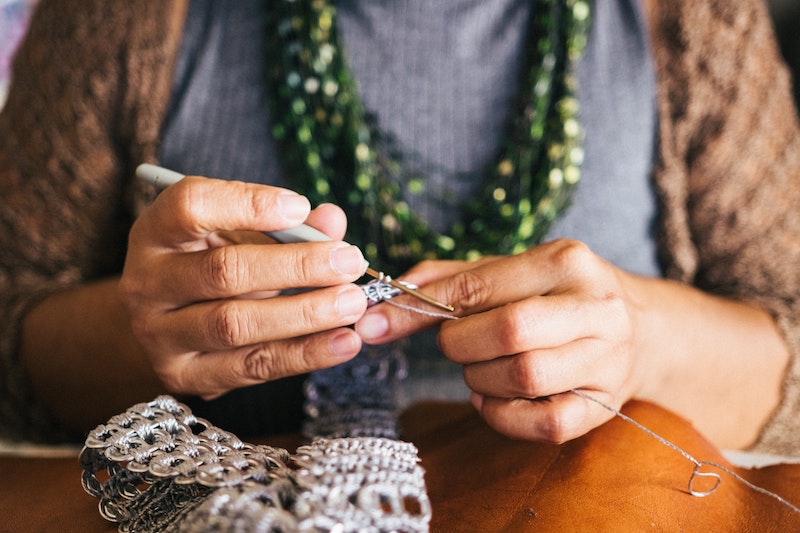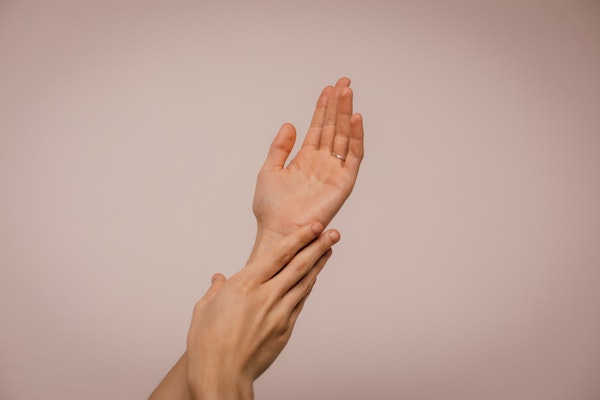
Knitting, sewing, and crocheting are not only fun hobbies, they can also be great for your health.
They’re known to reduce stress, boost self-esteem, and promote dexterity and stretch in the hands and fingers.
(Plus, after all that work, you end up with some pretty cool gifts or keepsakes!)
But too much time spent sewing or knitting can take a toll on your body. While the repetitive movements can be good for your fingers and hands in small doses, too much can lead to joint pain and discomfort.
Plus, spending hours and hours sitting hunched over a project can wreak havoc on your shoulders, back, and even your eyes.
So after interviewing doctors, personal trainers, and people who work with their hands for a living, here are the best hand, wrist, shoulder, and neck exercises for knitters to stay nimble and healthy.
- Stretch your fingers. Spread them wide, pull them tight, and repeat several times to loosen them up.
- Stretch your wrists. A simple flex and extend motion done a few times should keep your wrist feeling great.
- Stretch your shoulders. I like a good shoulder roll to relieve tension. Roll them forward, then backward, and repeat.
- Stretch your neck. Neck rolls can be tough if you’re not used to them, but that’s a sign you should do them more often! Swivel your head around your neck in a circle as far as you feel comfortable, then reverse the motion.
I’ll go into a lot more detail below with even more stretches and exercises from experts. Now let’s go!
1. Finger stretch
Here’s a simple exercise you can do in between knitting sessions to keep your fingers feeling great.
It comes from Lynell Ross, a certified health and wellness coach and personal trainer.
“Start with your hands stretched out in front of you, palms facing up.
Curl in both pinky fingers toward the center of your palm, then follow with your ring fingers, your middle fingers and index fingers. Once these fingers are all curled into your palm, cross your thumbs over the top.
Hold for a couple of seconds, take a deep breath, then release your thumb, opening wide, then one at a time, release the rest of your fingers in order, first your index finger, middle finger, ringer fingers and lastly your pinky.
Stretch all your fingers, opening your hands as wide as possible.
Repeat this exercise 8 times.”
2. Finger spreads
Here’s a simple but extremely effective one to help straight those fingers back out after hours of curling them up!
Hold your hand out in front of you and keep it relaxed.
Spread all five fingers out as wide as they can possibly go and hold this position for a few seconds.
Pull your fingers back in tight and curl them into a fist. Squeeze and hold for a few seconds.
Repeat a few times to loosen your hands and fingers up before resuming your work.
3. Knuckle bend
The knuckle bend comes from Lynell Ross again and will help improve your range of motion in the upper part of your fingers.
“Start by holding your hand and fingers straight and close together.
Bend the end and middle joints of your fingers. Keep your knuckles straight.
Moving slowly and smoothly, return your hand to the starting position.
Perform this exercise 8 times on each hand.”
Tip: You might need to hold the base of your fingers steady at first to prevent bending at the bottom rather than the knuckle.
4. Thumb stretch
One more from Ross, focusing on the ever-important thumb:
“Start with your hand in a relaxed position with your fingers and thumb straight.
Next, bend your thumb across your palm, touching the tip of your thumb to the bottom of your small finger.
If you can’t make your thumb touch, just stretch it as far as you can comfortably.
Return your thumb to the starting position. Repeat this exercise 8 times with each hand.”
5. Coffee tin & rice trick
Here’s a really cool exercise and hand-strengthening drill you can try courtesy of Pittsburgh Chiropractor Dr. Alex Tauberg.
“My favorite exercise, that is easy to do at home, for strengthening the hands is to get a coffee tin and fill it with rice, then drop in 10-20 dimes.
Mix the rice up so the dimes drop to the bottom, then put your hand in and try to pick out all of the dimes you put in.
Repeat 2-3 times.
While this doesn’t sound like much your hand will be burning by the time you get to the 5th dime.
This exercise is great because it helps to improve strength with fine motor skills.”
6. Wrist flex and extend

An oldie but a goodie, this one should really help to loosen up that cramping wrist after hours of sewing or knitting.
“Knitting, sewing, typing, and many other activities can be demanding on the hands, fingers, and even the wrists. This can quickly escalate into painful problems, leading to hands and wrists that are not only sore but also stiff and uncomfortable,” writes Thomas Bradbury, Technical Director at Getsongkey.
“There are a few different exercises that you can follow to help reduce the impact that these activities have on your hands.”
“The common wrist flex and extend is one of the popular options.”
Just flex your wrist, curling it in toward your forearm, hold and squeeze, and then extend it, stretching it backward as far as it will comfortably go (and hold and squeeze!)
“While it seems like a relatively simple exercise, it does have proven benefits. This particular activity is also useful for people with carpal tunnel syndrome.”
7. Reverse prayer hands
Our next exercise for knitters comes from a veteran sewer and knitter, Hila Willing over at Saturday Night Stitch.
“The reverse prayer hands is the best exercise to do before, during and after your stitching tasks. It is great for wrist and upper back pain.
“Keep your spine long and as you inhale bring your arms behind you. Exhale and with the next inhale point the palms of your hands towards each other as you rotate your arm.
“Relax and take a few deep breaths.
“At the next inhale rotate your the tips of your fingers along your spine as you open your chest. With your hands in prayer stance behind you, take a few more deep breaths before relaxing.
“Do this every 45 – 60 minutes when engaged in sewing or knitting.”
I also love a variation of the reverse prayer hands done in front of your body:
Bring your hands together at your chest as if praying, then rotate your fingers down toward the ground.
You’ll get an excellent stretch on your wrists and forearms.
8. Shoulder shrugs & rolls
Don’t forget your shoulders! If you’ve been spending hours hunched over a sewing, knitting, or crocheting project, they’ll tend to get a little stiff.
I love shoulder shrugs and rolls to keep them loose.
Shoulder shrugs are simple. Sit up straight, with good posture, then bring your shoulders up to your ears. Hold in this position and squeeze your shoulders and trap muscles, then slowly release.
Repeat this several times as necessary.
Shoulder rolls feel great, as well. Sit or stand straight, then roll your shoulders up to your ears and then forward and down. Now reverse the movement — roll them up toward your ears, back, and then down again in one smooth motion.
9. Neck rolls
Staring down at a project for hours can put a terrible crick in your neck.
Better ease it out with some neck rolls.
Start with your spine and neck straight, looking straight ahead of your.
Tilt your head back as far as it will go and let your gaze drift to the ceiling.
Gently roll your head to one side, then down (bringing your chin toward your chest), and then up toward the other side, and finally back to the tilted-back position.
Now reverse the movement and repeat as many times as necessary.
If you’re not used to this stretch, you may find your neck cracking and popping! Don’t push yourself to do anything that hurts, though.
More finger and wrist stretches
For some more ideas, check out these hand, finger, and wrist exercises to help prevent Carpal Tunnel courtesy of the Cleveland Clinic.
More knitting tips for healthy hands
There’s a lot more to keeping your body healthy while sewing, knitting, or crocheting than just stretching out your fingers every now and then.
Don’t forget these critical tips when you’re embroiled in long sessions!
Proper posture
Try not to allow yourself to stay hunched over for too long.
Keep your spine straight as often as possible, and if you do find yourself slouching, come up for air every now and then. Straighten out your back and bring your head back up into the world.
Your back will thank you later!
Eye breaks
Staring at anything too long can really hurt your eyes, especially things close to our faces like books, phones, and sewing projects.
Give your eyes a break every 20 minutes or so by looking up from your work. It’s best if you can find an object across the room or out the window to focus on for a minute or so before returning to your project.
Leg breaks & circulation
Sitting too long carries a ton of health risks and mental health side effects. It’s best to keep yourself moving and take breaks from sitting work as often as possible.
Set a timer for yourself every 30-45 minutes to get up and stretch your legs. Walk around the house, use the restroom, get yourself a drink of water. Do anything you can to get the circulation moving back through your legs and body!
(Related: What to do about sore legs after a workout)
Wrapping Up
Intricate craftwork like sewing or knitting can have a ton of health benefits, both physical and mental.
I’ve ever heard of bulky NFL players taking them up on the side to relax and build better fine motor skills!
But do be careful about all the wear and tear on your fingers, wrists, and back.
I’m no doctor, but I believe you’ll feel a lot better implementing some of these stretches and other exercises into your routine, especially during long working sessions.
Did I miss anything? What do you do to keep your fingers and hands feeling good while crocheting or knitting?
(If you’re new to exercising and getting fit, check out my guide to the best fitness and workout apps.)